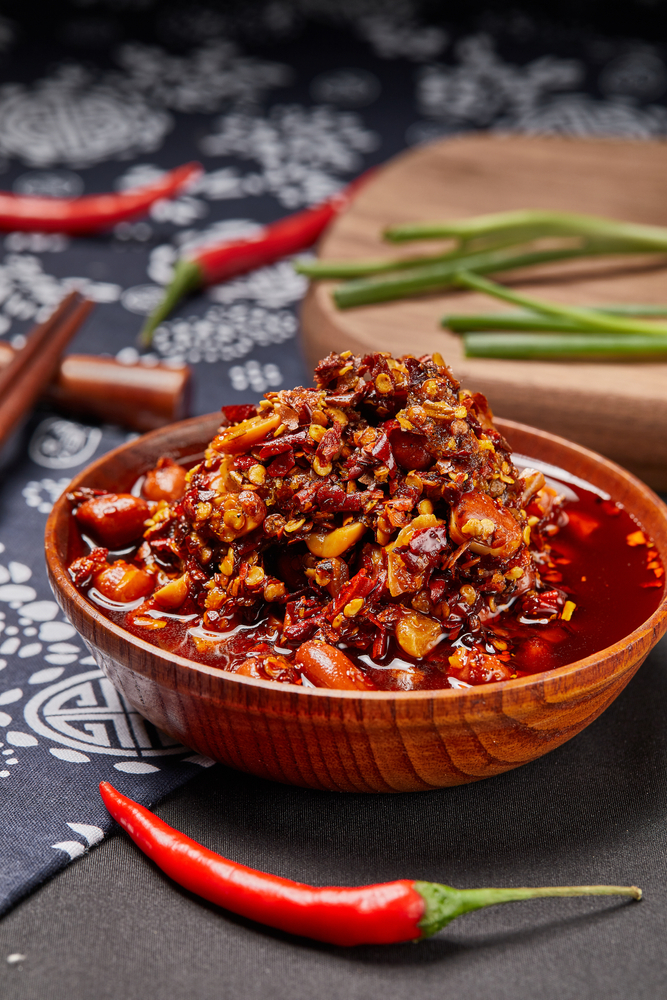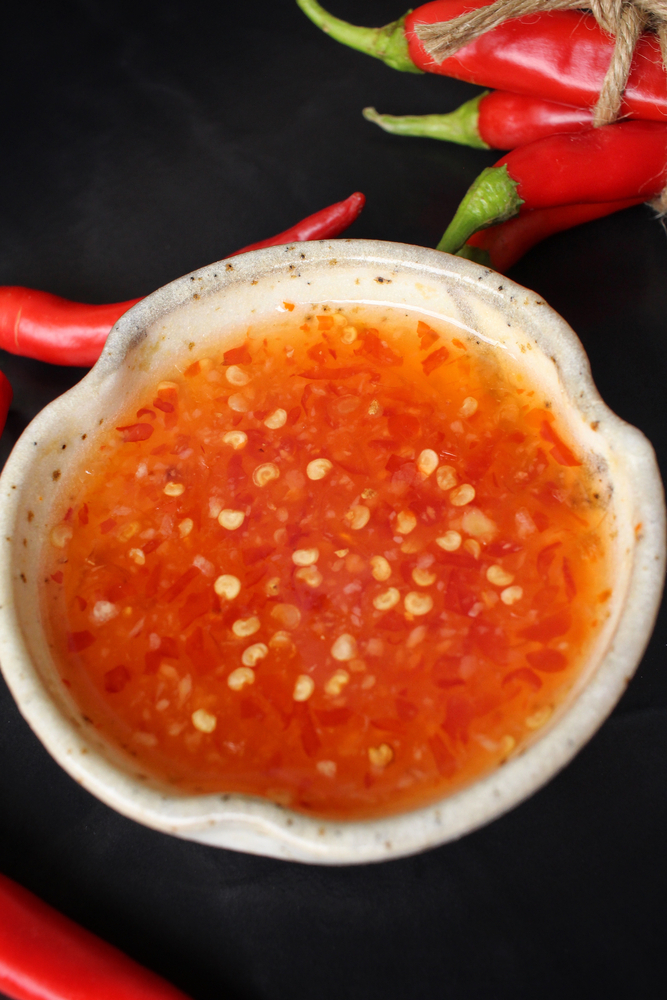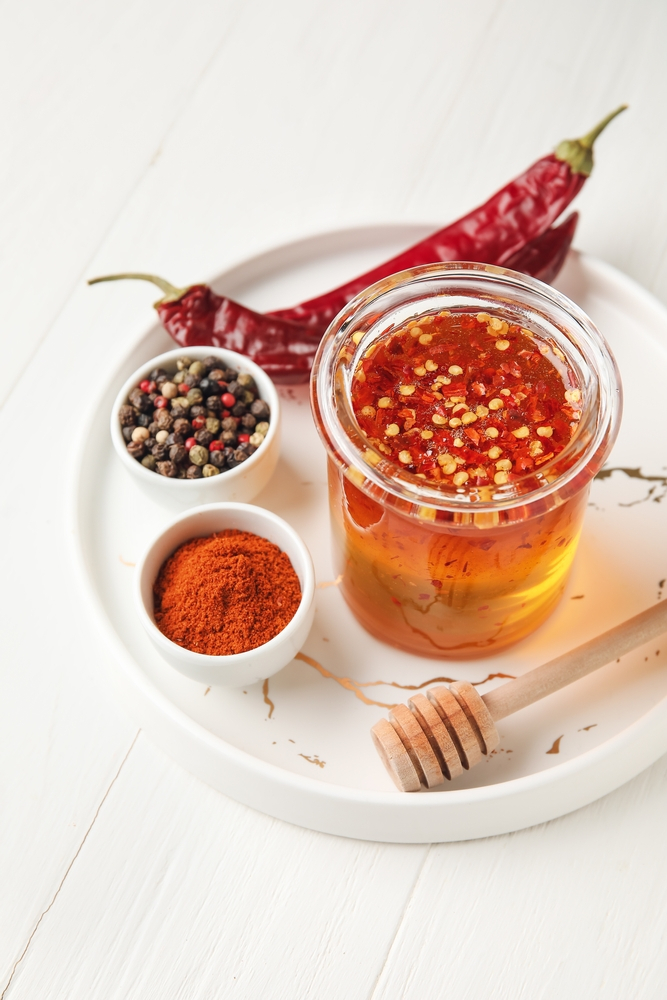
Chili oil is a condiment made from chili peppers and oil. The peppers are often dried, ground, or whole, and can be combined with other ingredients such as garlic, ginger, star anise, bay leaf, and spices.
The oil used in chili oil can be any type of oil, but commonly used oils are grapeseed oil, sesame oil, or peanut oil.
The chili peppers and oil are combined and heated, allowing the flavors and heat to infuse into the hot oil. The resulting chili oil can be used as a condiment or as a cooking ingredient in various cuisines, particularly in Asian cuisine such as Chinese, Korean, and Japanese.
Chili oil can be found in different levels of spiciness, some are mild and others are very hot. Chili oil is often used as a condiment for noodles, dumplings, and soups. It can also be used as a marinade or a finishing oil for dishes such as stir-fries, meat dishes, and vegetables.
Hot chili oil is a popular condiment for many people because of its combination of heat and flavor. The chili peppers used in chili oil provide a strong, spicy kick that can add depth and interest to a dish.
Additionally, the oil used in chili oil can provide a rich, savory base that can complement the heat of the chili peppers.
The complex flavor profile of chili oil makes it versatile and adaptable to different cuisines. It can be used as a simple condiment, or as a cooking ingredient to add heat and flavor to a dish.
The oil can also be infused with other ingredients such as garlic, ginger, and spices, which can further enhance the flavor profile of the chili oil.
Another reason people love chili oil is that it is a great way to add heat to a dish without changing the overall flavor profile.
This can be especially useful for dishes that have a delicate or complex flavor that you don’t want to overpower, but you still want to add some heat.
Chili oil substitutes:
A list of great options to substitute chili oil.
- Sriracha sauce: This Thai hot sauce is made from chili peppers, vinegar, sugar, and garlic. It has a similar level of heat to chili oil and a slightly sweeter, more garlicky flavor.
- Sambal oelek: This Indonesian chili paste is made from ground chili peppers and salt. It has a similar level of heat to chili oil and a more earthy, less sweet flavor.
- Gochujang: This Korean chili paste is made from chili peppers, glutinous rice, fermented soybeans, and salt. It has a similar level of heat to chili oil and a sweet, savory, and slightly smoky flavor.
- Harissa: This North African chili paste is made from chili peppers, garlic, olive oil, and spices. It has a similar level of heat to chili oil and a more complex, earthy, and spicy flavor.
- Red pepper flakes: This is a spice made from ground dried chili peppers and has a similar level of heat as chili oil, but less complexity.
- Peri-Peri sauce: This African sauce made from African bird’s eye chili, lemon and garlic, it has a similar level of heat to chili oil and a tangy, spicy flavor.
- Louisiana Hot Sauce: This cayenne pepper-based sauce from the southern US, it has a similar level of heat to chili oil and a tangy, spicy flavor.
- Chipotle pepper in adobo sauce: This Mexican sauce made from smoked jalapeño peppers, tomato sauce and spices, it has a similar level of heat to chili oil and a smoky, spicy flavor.
- Szechuan pepper oil / Sichuan sauce: this Chinese oil made from szechuan pepper and chili pepper oil, it has a similar level of heat to chili oil and a numbing, spicy and fragrant flavor. Sichuan chili flakes: also known as Szechuan chili flakes or Szechuan pepper flakes, are a type of chili flakes that originate from the Sichuan province in China. They are made by drying and crushing whole Sichuan peppercorn and chili peppers. The flakes are known for their intense spiciness and characteristic numbing sensation.
- Cayenne pepper : a type of chili pepper that is commonly used in cooking, particularly in spicy and ethnic cuisines. Cayenne pepper has a strong, pungent, and slightly sweet flavor.
- Sweet chili sauce : is thick and has a sweet, tangy, and slightly spicy flavor.
- Chiu Chow chili oil: is a type of chili oil that originates from the Chiu Chow region in China. It is known for its intense spiciness and fragrant aroma. The oil is made by infusing whole dried chili peppers, such as Szechuan peppercorn and cumin, in oil. The oil is then combined with other ingredients such as garlic, ginger, and fermented soybeans
- Chili garlic oil: made from a combination of chili peppers, garlic, and other ingredients such as vinegar, sugar, and salt. The sauce is thick and has a spicy, slightly sweet flavor and garlic flavors. It can also be purchased pre-made at many grocery stores and Asian supermarkets
- Salsa macha: also known as “Mexican chili oil, is known for its intense heat and smoky flavor. The recipe for salsa macha may vary depending on the region and the cook, but it generally includes ingredients such as dried chili peppers (such as guajillo, ancho, or pasilla), garlic, salt and oil. Some variations may also include additional ingredients such as sesame seeds, peanuts, or Mexican spices like cumin and oregano. commonly used as a dipping sauce, a marinade, or a topping for various dishes
- Spicy soy sauce: also known as “hot soy sauce,” is a variation of traditional soy sauce that includes chili peppers or chili flakes for added heat. can be used as a dipping sauce, marinade or as an ingredient to add heat and flavor to a variety of dishes such as stir-fries, soups, and stews. It can also be used as a condiment for sushi and sashimi. Some popular dishes that use spicy soy sauce include spicy ramen, spicy udon, and spicy Korean fried chicken.
- Black bean sauce: has a strong, salty, and savory flavor and it is usually used to add depth of flavor to savory dishes. Add in some extra spices like chile flakes, red peppers, or chili powder to up the spiciness.

Keep in mind that these alternatives may not have the same heat level, and also may not have the same texture as chili oil but they will provide you with a similar taste.
There are many variations of chili oil, depending on the recipe and the type of chili pepper used. Some common ingredients include Sichuan peppercorns, garlic, ginger, and other spices.
Some chili oils are also made with fermented ingredients such as soybean paste, miso or black bean paste, which can add complexity to the flavor.
Chili oil can be used in a variety of ways, such as a topping for rice or noodles, as a marinade for meats, or as a dipping sauce for dumplings or spring rolls. It can also be added to soups, stews or stir-fries to add a spicy kick.
How long does homemade chili oil last
The shelf life of chili oil depends on several factors, including the type of oil used, the type of chili peppers used, and how it is stored. Homemade chili oil will typically have a shorter shelf life than store-bought chili oil, as it does not contain preservatives.
When stored in an airtight container and kept in a cool, dark place, chili oil can last for several months. If the oil is cloudy or has any discoloration or off-odors, it is best to discard it.
Refrigeration can extend the shelf life of chili oil, and it’s recommendable to do so if you are not planning to use it in a short period of time. When stored in the refrigerator, chili oil can last for up to a year or even more. Keep in mind that refrigeration can cause the oil to solidify, but it will return to liquid form once it reaches room temperature.
It’s important to note that homemade chili oil may not have a consistent shelf life as store-bought chili oil.
Tip: When making homemade chili oil its best to use oil with a high smoke point like avocado oil or grapeseed oil.

How spicy is chili oil?
The spiciness of chili oil can vary depending on the type of chili pepper used and the amount of chili pepper in the oil. Some chili oils can be very mild and only have a subtle hint of heat, while others can be extremely spicy and pack a significant amount of heat.
Chili oils made with dried chili flakes or whole dried chili peppers tend to be spicier than those made with fresh chili peppers. Oils made with Sichuan peppercorns can also have a numbing effect on the tongue, which can enhance the overall spiciness of the oil.
In general, the spiciness of chili oil can range from mild to extremely hot, and it is always best to start with a small amount and add more to taste. If you are sensitive to spicy food, you may want to start with milder chili oil or adjust the spice level used in the recipe if you’re not a fan of spicy food.
5 recipe ideas using chili oil:

- Spicy Sesame Noodles: Cook Chinese egg noodles or spaghetti and toss it with sesame oil, rice vinegar, soy sauce, and hot chili oil. Garnish with green onions, sesame seeds, and cilantro.
- Spicy Fried Rice: Cook rice and stir-fry it with vegetables such as peas, carrots, and bell peppers, along with scrambled eggs. Add hot chili oil to taste, and garnish with green onions and cilantro.
- Spicy Grilled Vegetables: Toss sliced vegetables such as bell peppers, eggplants, and zucchini with hot chili oil, garlic, and salt. Grill on medium heat until tender and serve as a side dish or as a topping for sandwiches or pizzas.
- Spicy Ramen Soup: Cook ramen noodles according to package instructions, and in a separate pot make a broth of chicken or vegetable broth and add hot chili oil, soy sauce, and sesame oil. Add cooked noodles and toppings such as sliced pork, boiled eggs, and bok choy.
- Spicy Korean Fried Chicken: Mix flour, cornstarch, and spices in a bowl, then coat chicken pieces in the mixture. Fry the chicken on high heat until golden brown and crisp, then toss in a mixture of hot chili oil, soy sauce, and honey. Serve with pickled radishes and green onions.
